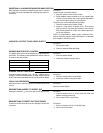
7
BASIC MIXER OPERATION
1. Turn on the Power switch.
2. Adjust each channel level so that its Overload LED flick-
ers only during very loud speech or noise.
3. Turn unused channel controls full counterclockwise.
4. Adjust the Low-Cut and High-Frequency controls adja-
cent to each Input Gain control until all microphones
sound alike.
5. Adjust the SCM800 Master level control for the desired
output level, as indicated by the output peak meter.
6. Adjust the headphones volume level with the PHONES
control knob.
LIMITER
The SCM800’s output limiter prevents distortion during loud
program peaks without affecting normal program levels. In-
creasing the individual or Master level controls will increase
the average output and, in turn, the amount of limiting. The lim-
iter prevents excessive overloading of devices connected to
the SCM800 output. As supplied, the limiter is defeated.
The limiter threshold can be set for a peak output level of +4,
+8, or +16 dBm. With the threshold set at +16 dBm, the mixer
has 12 dB of headroom at a nominal level of +4 dBm. Refer to
the Internal Modifications section for information on how to
change the limiter’s settings.
EQUALIZER FUNCTIONS
Low Cut Filter (High-Pass)
The low-cut (or high-pass) filter allows all frequencies above
its cutoff point to pass from filter input to filter output without at-
tenuation, while frequencies below the cutoff are attenuated
(see Figure 9). The cutoff point is defined as the frequency
where the signal has dropped 3 dB relative to the flat, or band-
pass, region. Below the cutoff point, the filter exhibits increas-
ingly more attenuation as the frequency diminishes. The rate
at which this attenuation occurs is defined in decibels per oc-
tave (dB/oct). The SCM800 has a one-pole, low-cut (high-
pass) filter of 6 dB per octave.
Low-cut filters are ideally used for attenuating, or rolling off, the
audio signal where extraneous noise, excessive proximity ef-
fect, or other unwanted material is present. For example, the
low-frequency vibration cause by footsteps and vehicle traffic
can be transmitted through microphone stands to the micro-
phone, and then into the sound system. These frequencies,
typically ranging from 5 to 80 Hz, are generally not desirable.
-10
-8
-6
-4
-2
0
+2
20 100 1,000 5,000
FREQUENCY (Hz)
FULL CCW
50%
ROTATION
FULL CW
LOW–CUT FILTER EFFECTS
FIGURE 9
High-Frequency Shelving
The fixed-frequency equalizer produces a 6 dB boost or cut at
5 kHz and above (see Figure 10). High-frequency shelving is
extremely useful for boosting flat frequency response, temper-
ing very sibilant vocal microphones, or enhancing the sound of
off-axis lavalier microphones.
200
-10
-8
-6
-4
-2
0
+2
+4
+6
+8
+10
1,000 10,000
20,000
FREQUENCY (Hz)
FULL
CW
FULL
CCW
50%
ROTATE
HIGH-FREQUENCY SHELVING EFFECTS
FIGURE 10














